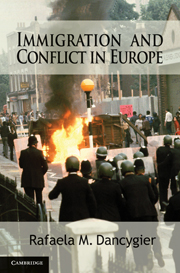Book contents
- Frontmatter
- Contents
- List of Figures and Tables
- Acknowledgments
- PART I GENERAL INTRODUCTION AND THEORETICAL FRAMEWORK
- 1 Introduction
- 2 A Theory of Immigrant Conflict
- PART II INTRODUCTION TO PART II
- PART III INTRODUCTION TO PART III
- PART IV INTRODUCTION TO PART IV
- 9 Conclusion
- Appendix A Coding Large-Scale Instances of Immigrant–Native and Immigrant–State Violence
- Appendix B Data and Variables: Immigrant Turnout
- References
- Index
- Titles in the series
2 - A Theory of Immigrant Conflict
Published online by Cambridge University Press: 17 November 2010
- Frontmatter
- Contents
- List of Figures and Tables
- Acknowledgments
- PART I GENERAL INTRODUCTION AND THEORETICAL FRAMEWORK
- 1 Introduction
- 2 A Theory of Immigrant Conflict
- PART II INTRODUCTION TO PART II
- PART III INTRODUCTION TO PART III
- PART IV INTRODUCTION TO PART IV
- 9 Conclusion
- Appendix A Coding Large-Scale Instances of Immigrant–Native and Immigrant–State Violence
- Appendix B Data and Variables: Immigrant Turnout
- References
- Index
- Titles in the series
Summary
In this chapter, I present an in-depth overview of the book's theory of immigrant conflict. I begin by providing my conceptualization of both types of conflict, immigrant–native and immigrant–state conflict, and go on to describe their indicators. I next address the two key independent variables, economic scarcity and immigrant political power. In specifying when and where immigrant destinations are likely to be affected by economic scarcity, I pay particular attention to the role of national immigration regimes. The rules and regulations that govern the arrival, recruitment, and settlement processes of migrant newcomers, I argue, can have important effects on the supply of and demand for economic resources at the local level. In my discussion of immigrant political power, I highlight the importance of national political institutions – citizenship regimes, voting laws, and local electoral systems – as well as the political behavior of immigrant-origin ethnic minorities. Having established the conceptualization of the key variables, I turn to an exposition of the book's theory of immigrant conflict. In spelling out the logic that underlies the central argument, I further draw attention to the importance of state actors – rather than market actors – being in charge of disbursing material goods that are in short supply. Moreover, I state the assumptions on which the book's theoretical model of immigrant conflict rest. In the final section, I consider how the book's argument contributes to the existing literature on intergroup conflict and the domestic consequences of immigration.
- Type
- Chapter
- Information
- Immigration and Conflict in Europe , pp. 21 - 58Publisher: Cambridge University PressPrint publication year: 2010

